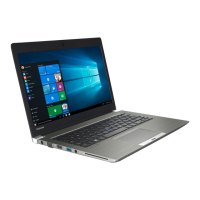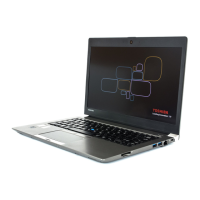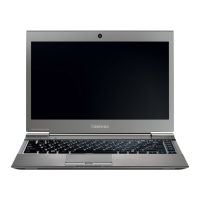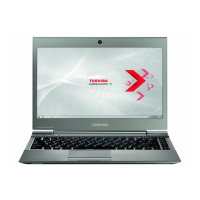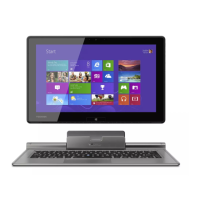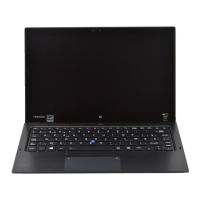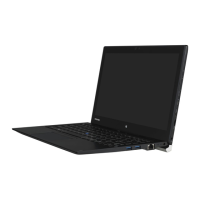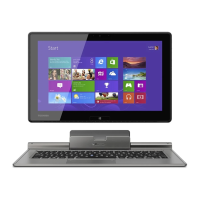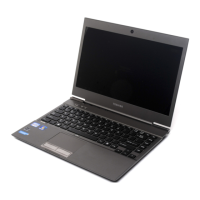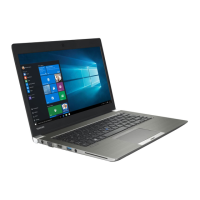
Do you have a question about the Toshiba PORTEGE Z30-C and is the answer not in the manual?
| Graphics | Intel HD Graphics 520 |
|---|---|
| Operating System | Windows 10 Pro |
| Storage | 256GB SSD |
| Weight | 1.2 kg |
| Ports | 3 x USB 3.0, HDMI, VGA, SD card slot |
| Wireless | Wi-Fi 802.11ac, Bluetooth 4.1 |
| Dimensions | 316 x 227 x 15.9 mm |
Covers copyright, disclaimers, and trademarks for the manual and product.
Provides information on regulations applicable to the computer, such as FCC and California Prop 65.
Licensing information for video standards like AVC, VC-1, and MPEG-4.
Details licensing terms for OpenSSL toolkit and FreeType project software.
Lists included items, explains manual conventions, and defines short model names.
Provides basic steps and guidance for initial computer setup and use.
Introduces Windows operating system features like Start menu and taskbar.
Explains how to properly shut down the computer and its implications.
Details methods for restarting the computer and important precautions.
Explains how to use Sleep Mode to conserve power and its benefits and limitations.
Describes Hibernation Mode for saving system state and power.
Outlines options for system recovery, including creating recovery media.
Identifies components and ports for the Z30-C model.
Explains indicator lights and lists ports on the left side of the Z30-C.
Details specific ports on the Z30-C left side, like USB 3.0 and HDMI.
Identifies ports on the Z30-C right side and the memory media slot.
Details specific ports on the Z30-C right side, like SIM card slot and LAN jack.
Identifies cooling vents, docking port, and other underside features of the Z30-C.
Explains the docking port and shows the Z30-C with its display open.
Identifies front components like antennas and webcam for Z30-C when the display is open.
Describes the display screen, hinges, and keyboard functionality for the Z30-C.
Explains input devices and indicators for the Z30-C.
Identifies front components for the Z40-C model.
Explains indicator lights and lists ports on the left side of the Z40-C.
Details specific ports on the Z40-C left side, like USB 3.0 and HDMI.
Identifies ports on the Z40-C right side and the memory media slot.
Details specific ports on the Z40-C right side, like SIM card slot and LAN jack.
Identifies back and underside components for the Z40-C model.
Explains the docking port and shows the Z40-C with its display open.
Identifies front components for the Z40-C when the display is open.
Describes display, hinges, and keyboard functionality for the Z40-C.
Explains input devices and indicators for the Z40-C.
Details key internal hardware components like battery pack and CPU.
Explains the meaning of different indicator lights for power and battery status.
Explains basic touch screen gestures like tap, press and hold, pinch, rotate, and slide.
Describes touch pad gestures including tap, two-finger tap, pinch, and scroll.
Introduces keyboard layout, indicators, and function keys.
Details the functions of F1-F12 keys and FN key combinations.
Explains the function of Windows logo key and application key.
Describes how to use the AccuPoint pointing device and its precautions.
Explains how to enroll and use the fingerprint sensor for authentication.
Covers battery types, care, charging, and monitoring battery capacity.
Explains how to install a SIM card for wireless WAN connectivity.
Covers SIM card removal and mentions the GPS function.
Covers LAN connection, cable types, and setup.
Details memory media slots, card types, care, and formatting.
Explains the use of Smart Cards, insertion, and removal.
Covers connecting external displays via RGB or HDMI ports.
Describes port replicator connection and external playback settings.
Explains security lock usage and lists optional accessories.
Covers audio controls like Volume Mixer, DTS Studio Sound, and Realtek HD Audio Manager.
Describes pre-installed utilities and the TOSHIBA configuration tool for managing system settings.
Details eco Utility for power management and USB Charge features like Sleep and Charge.
Explains how to set up User and Supervisor passwords for system security.
Guides on using Service Station for updates and accessing the BIOS setup utility.
Explains the Maintenance Utility for drive erasure and advanced system features.
Outlines steps for diagnosing problems and basic preliminary checks.
Guides on analyzing issues by asking questions and checking software/hardware.
Covers issues like unresponsive keyboard, frozen programs, and computer not starting.
Lists common hardware and system areas where problems might occur.
Troubleshoots overheating, AC power, and battery-related problems.
Addresses problems with BIOS settings, lost date/time, and power-on failures.
Covers keyboard and display panel problems such as garbled output or no display.
Troubleshoots slow HDD performance and memory media card errors.
Addresses Touch Pad problems and common issues with USB mice.
Troubleshoots fingerprint sensor registration and general USB device problems.
Provides information on contacting TOSHIBA for technical assistance.
Summarizes technical specifications including physical dimensions and environmental requirements.
Details power requirements and pin assignments for external RGB monitor port.
Specifies requirements for AC power cords and connectors, including certifications.
Covers wireless technology interoperability, standards, and health considerations.
Explains Wireless LAN technology, security, and Bluetooth technology.
Lists radio regulatory information and usage restrictions for various regions.
Provides information about Intel Active Management Technology (AMT) and how to disable it.
Directs to Intel's website and provides notes for system administrators regarding AMT.
Contains legal notes related to CPU performance and general usage conditions.
Discusses 64-bit compatibility and how system memory is utilized.
Covers battery life, storage capacity, LCD characteristics, and wireless LAN factors.
